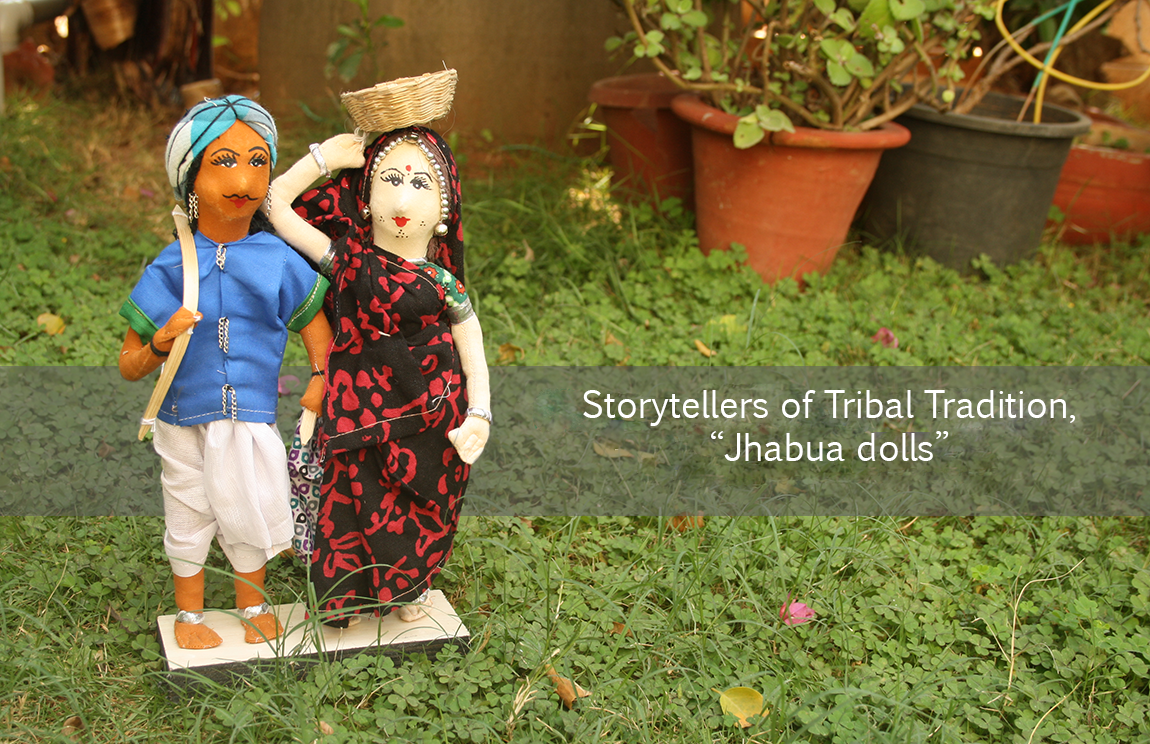Watch “Miniature project” on YouTube
Passion for miniature
Miniature love 🤗🥰
Alternative Medium for children to draw attention away from Screen Entertainment.
As a student of textile design at a craft-oriented college in Rajasthan, I was given the opportunity to delve deep into the rich cultural heritage of India. My specialization in textile design allowed me to gain a unique understanding of how cultural influences, such as history, geography, and climate, shape the indigenous clothing and craft traditions of different regions. This sparked my curiosity to not only appreciate the craftsmanship, but also to gain a deeper understanding of the lifestyle and culture of the craftspeople.

I love to travel, although it’s not that easy to do it on top of a professional 9-to-5 job, but somehow I manage to do it when I want it badly enough.
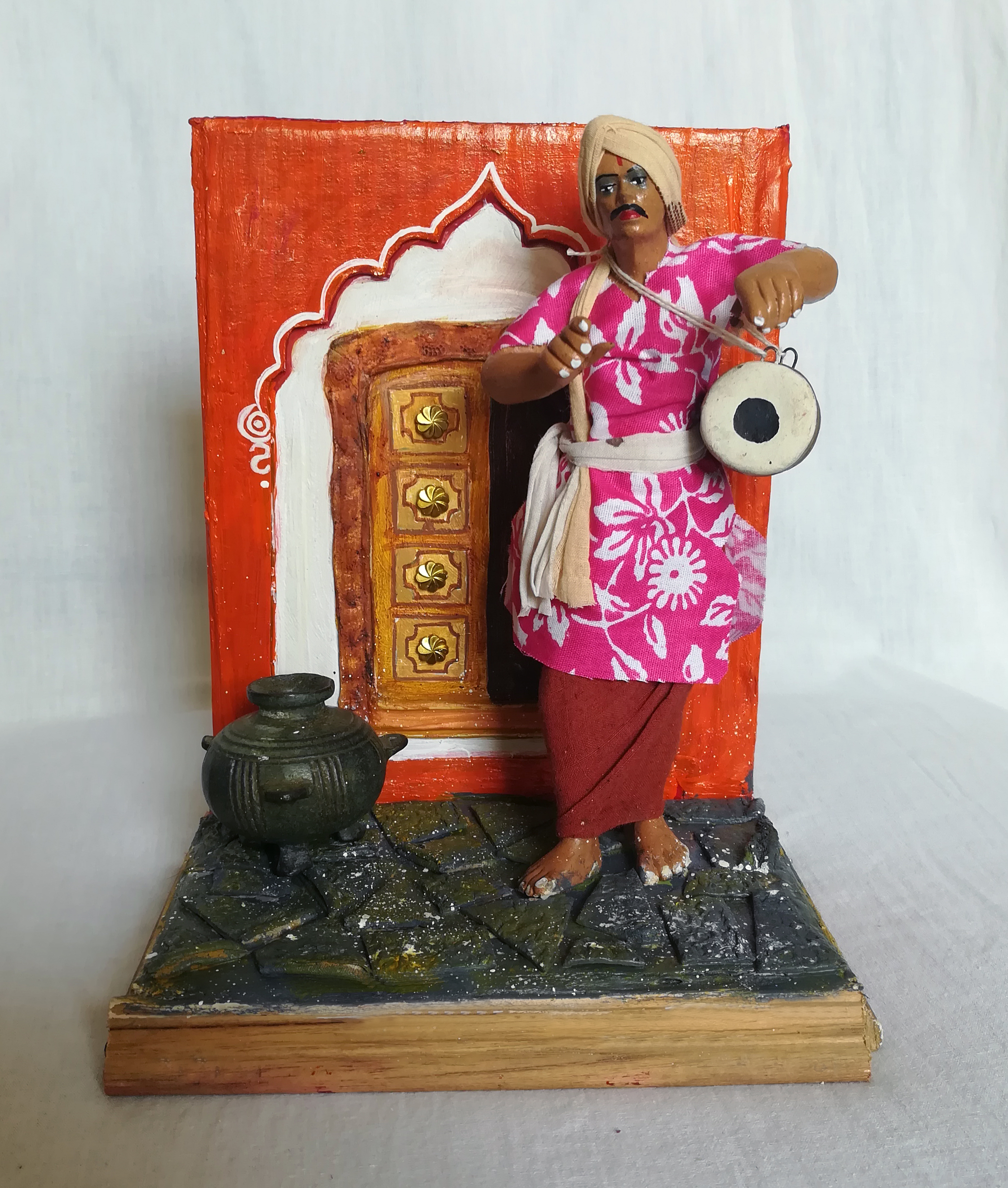
The culture of India is one of the most ancient and unique. The South, the North and the Northeast have their own distinct cultures and almost every state has created its own cultural niche. There is hardly any culture in the world as diverse and unique as India’s. But due to urbanization of young generation on one hand, where we are becoming a multicultural society, on the other hand, we are losing our distinct tradition and its cultural values.We can clearly understand as if, so many rituals and customs followed our grandparents; in the next generation my mother unable to follow them all. In fact, in inheritance, I will also not be able to follow half of what my mother does now. This would happen due to lack of resources, knowledge and interest.

So if the majority of the generation ignores its culture and its values, it cannot survive for long. So here we can understand where it is going, but no!!! We don’t want our unique and diverse culture to be written off. So the question is how we can protect it.
Culture in itself is a very vast subject; we can divide it into two: tangible and intangible.

In the following bullet points, we need to think on an individual level about our own part of the contribution to connect the next generation to the culture. As parents, it is our job to choose the right opportunity and place to help them explore, investigate, create and question everything around them.


This is where I put my small efforts by creating ‘ TANGIBLE MINIATURE’ artworks to promote cultural education. I believe these artworks will ENCOURAGE parents to engage with children. I choose parents to cover the intangible aspects of these cultural artworks. So you can teach them about their own roots, original culture and values. Those memories they may have collected in their lives, over a period of time. It would be just like presenting them with your family photo album, where they begin to recognize your family friends and events because of your detailed description.

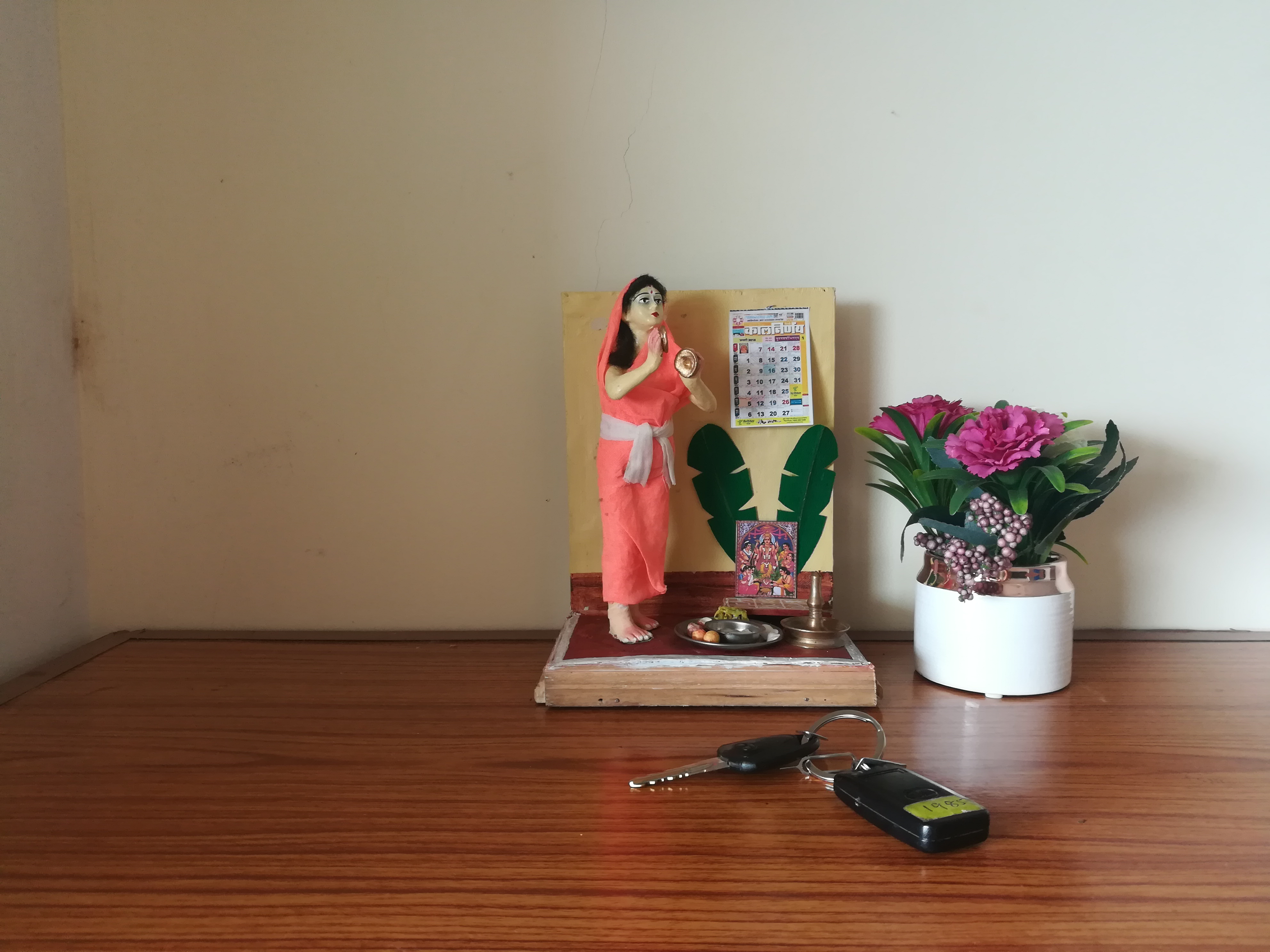
I choose the subject of the artworks from different distinct cultures. In the first series, I covered the culture of North Indian. In order to get more clarity on their historical aspects, I will treat a whole article on each of them

while working and observing the pattern of learning for kids in past 3 years , I found that there are mainly 7 ways to make them learn anything –

1-visual, 2- aural, 3- social, 4-solitary, 5- physical, 6- logical, 7-verbal.
Here parents, teachers, friends and society play a great role in building the character and cultural knowledge of the children because only parents and teachers can play the best role in connecting them to their culture as they are the closest to them. I strongly believe that the visual, social and verbal communication bridge will be an alternative to keep children away from screen entertainment where they are only trapped in someone else’s simulation.
Knowledge of culture will open up a whole new realm of imagination and understanding for Cultural Revolution. It will give them food for thought to play with their own imagination.
Boredom challenges children to discover their own passions
If you go back a few hundred years, learning was always one that took place in an open space through constant interaction and personal experience.In the last few decades, somewhere in between, learning is compressed into closed spaces and teaching becomes more theoretical where there is only constant interaction but no space for personal experience. We need to understand that not all learning takes place in classrooms ” compare and contrast knowledge gained through personal experience. To develop personal experience, you needed time to interact with yourself, to become curious about your interests.

Sports, music, and other organized activities can certainly enhance a child’s physical, cognitive, cultural, and social development. But children also need time to themselves – Remember, children are always happiest in self-directed play. This is because play is what children do. It’s how they learn to process the emotions and experiences they’ve had.

Observe any group of playing children, and they will organize themselves into some sort of activity, whether it be building a human train, pretending to be a doctor, and attending to the problems of patients.

Sometimes I’ve noticed that parents often feel guilty when children complain about boredom. But actually, it’s more constructive to see boredom as an opportunity rather than a deficit. Parents should understand that rushing in with ready-made solutions is not helpful.

Boredom plays a crucial role in child development because it gives children the opportunity to explore their inner and outer worlds, which is the beginning of creativity. This is how they learn to engage with themselves and the world, to imagine, invent and create.
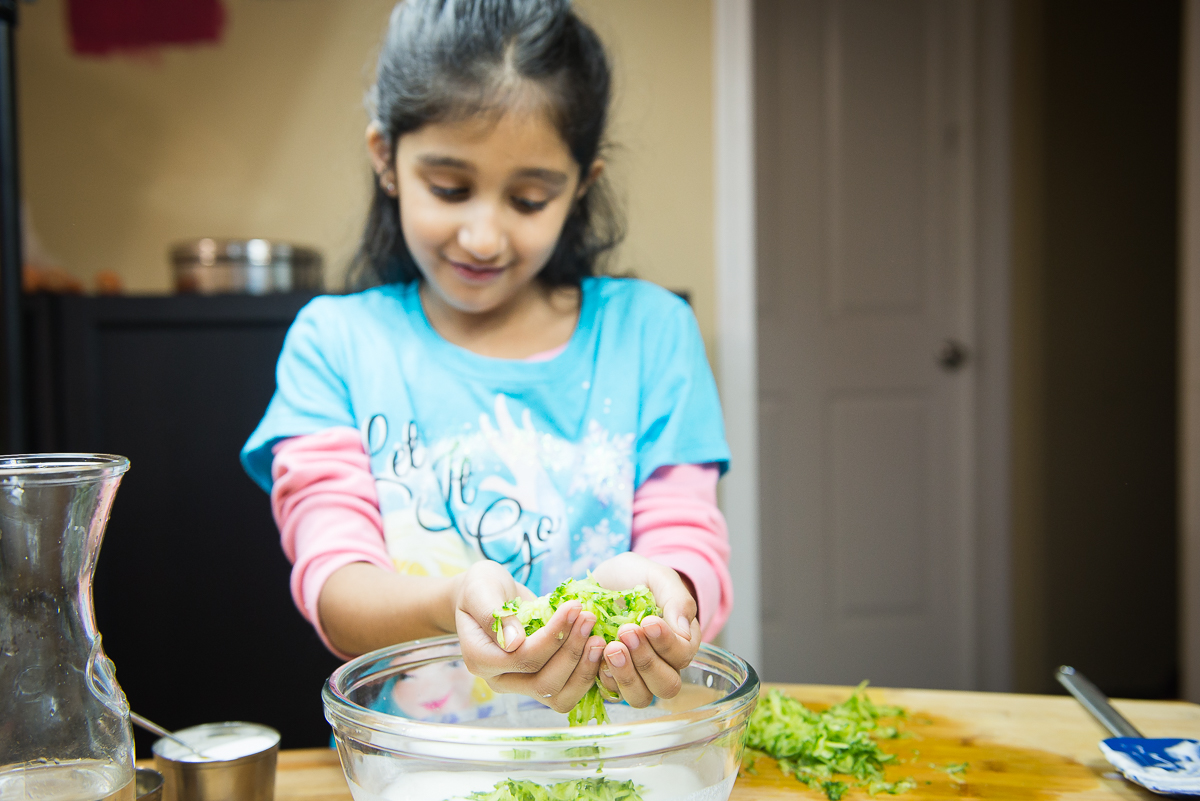
Boredom challenges children to discover their own passions. When we keep them busy with lessons and structured activities or fill their time with screen entertainment, they never learn to act on their own interests, which might include making a doll out of scraps of fabric, writing a short story, or simply reading comic books or imagining their own superhero and his new superpowers.

It is these calls of our heart that lead us to those passions that make life meaningful, and they are available to us from childhood – but only if children are given free rein to explore and pursue where their interests lead them.
 Indeed, there is a lesson here for all of us. Switching off, doing nothing and letting your mind wander can be great for adults too – we should try that ..
Indeed, there is a lesson here for all of us. Switching off, doing nothing and letting your mind wander can be great for adults too – we should try that ..
The festival of Jagannath Rath Yatra
‘Jagannath Puri’, Rath Yatra are organized once a year. Jagannath Puri is one of the four ‘DHAMs’ in the Hindu Culture. It is located in the holy city of ‘Puri’ in the state of Orissa, in the eastern part of India; the other three ‘DHAMs’ are located:
 Dwarika in the west, Badrinath in the north and Rameswaram in the southern part of India and today I will share some interesting facts about “The Jagannath Rath Yatra”.
Dwarika in the west, Badrinath in the north and Rameswaram in the southern part of India and today I will share some interesting facts about “The Jagannath Rath Yatra”.

The Jagannath temple has a long and rich history. On the second day of the bright fortnight of the month of Asadha (June), the festival Jagannath Rath Yatra is celebrated in the pilgrim city of Puri. It is the day when the gods come out on the Royal Chariots and visit the Gundicha temple.

The embodiments of 3 deities, Jagannath and his siblings Balabhadra and Subhadra, have taken from the temple to the streets of Puri. Devotees use their combined strength to pull the chariot with ropes to the Gundicha temple.

.Meanwhile, there is a ritual known as “Chedaphahra” in which the king of Puri sweeps the ground before Jagannath He sweeps all 3 chariots with the gold handled broom and sprinkles sandalwood water on the first and last day of the yatra.

After 9 days, these deities are taken from the temple of Gundicha back to the maintemple Shree Jagannath. On the way back, the 3 deities hop into a temple called Mausi MAA temple and get the feast ” Pada Pitha” (a kind of baked cake).

When we were kids, we usually watched Jagannath Yatra on our TV. But we never tried to figure out why this ritual was taking place… Why is there a king sweeping around in chariots, Why do these gods come out every year.
Recently I came across some very interesting facts about Jagannath Puri. So I thought let’s share them with you.

Legendary account, as found in the Skanda-Purana, Brahma Purana and other Puranas, that the original image of Jagannath (a deity form of Vishnu) manifested itself in the form of a Blue Jewel near a banyan tree near the seashore at the end of Treta Yuga. This blue jewel came out of Lord Krishna’s heart (ppl say it is Krishna’s heart which are not burnt out during cremation of Krisha’s body) his body was gone but this Padma (Blue Jewel) remained on earth. It was so dazzling that it could grant instant moksha, so the God Dharma and Yama wanted to hide it in the earth, which they succeeded in doing. In the Dvapara Yuga, Lord Jagannath was originally worshipped by a Savar king (tribal chief) named Viswavasu. Hearing of the deity, King Indradyumna sent a Brahmin priest and his brother Vidyapati to find the deity being worshipped
Worshipped secretly in a dense forest by Viswavasu.

Vidyapati tried his best but could not locate the place. But finally he succeeded in marrying Viswavasu’s daughter Lalita. On several requests of Vidyapti, Viswavasu took his son-in-law blindfolded to a cave where Lord Neela Madhava was worshipped.
Vidyapati was very intelligent. On the way, he dropped mustard seeds on the ground. The seeds germinated after a few days, which later enabled him to locate the cave. After hearing about Vidyapati, King Indradyumna proceeded immediately to Odra Desha (Odisha) to see and worship the deity. But the deity had disappeared. In fact, the deity was hidden in the sand. The king was disappointed and decided not to return without having a darshan of the deity and observed fast unto death at Mount Nilgiri. The King Indradyumna was informed by Narada of Brahma’s message: that the king must worship the deity with a thousand Ashwamedha yajnas (yug).

OVER one thousand Aswamedh yug: the divine voice of Neela Madhav instructs Indradyumna as:
“In this world I will not give you darshan in the form of Neela Madhava but I will manifest myself in four forms: Jagannatha, Balabhadra, Subhadra and Sudarshan Chakra. Wait near the river bank and a daru (trunk of a neem tree) will float. I will manifest in the form of a very large, fragrant, reddish trunk, and the signs of Sankha, Chakra, Gada and the Padma will be seen everywhere in that form. Go there and take me out and make four deities out of that log. Then you will be able to worship me”.
When this tree-trunk, radiant with light, hovered over the sea, Narada commanded the king to make three idols of it, and to set them up in a pavilion
 Indradyumna induced Visvakarma, the architect of the gods, to build a magnificent temple to set up the images of the gods, and visvkarma himself appeared in the guise of a carpenter to make the images of the gods, on condition that he should remain undisturbed until he had finished the work.
Indradyumna induced Visvakarma, the architect of the gods, to build a magnificent temple to set up the images of the gods, and visvkarma himself appeared in the guise of a carpenter to make the images of the gods, on condition that he should remain undisturbed until he had finished the work.

But after only a fortnight the queen became very uneasy. She supposed that the carpenter was dead, because no sound came from the temple. Therefore she asked the king to open the door. So they went to see Viswkarma at work, whereupon he gave up his work and left the idols unfinished. The idols had no hands. A divine voice told Indradyumana to set them up in the temple. And thus came about the foundation of the temple of Jagannath.

Following the same pattern, every once in a while deity in the temple of Puri presided over by Jagannath dies and then comes back to life. Jagannath’s sister Subhadra and brother Balabhadra also undergo the same change. This tradition, known as NOBHAKODA, has been taking place for the last 4000 years. It happens when an extra month is added to the traditional calendar year, which happens every 14 to 19 years. 2015 was one of those years.
It is quite an interesting phenomenon through which like Lord Jagannath’s rebirth takes place. A Special Neem tree named Darubramh; which has no nest, ant hill and snake lives near this and contains symbols of Vishnu. These are cut down and transported to the pilgrimage town of Puri, where they are carved according to certain ritual guidelines. Then, on a certain night, the government declares a complete blackout in Puri and a special blindfolded priest transfers something mysterious from the old image of Jagannatha to the new one. This substance is called “Bramh Pradarth” but no one really knows exactly what it is. People believe that it is the same Blue Jewell that is worshipped as Neela Mahadev.


After the rituals, Jagannath’s ancient image is buried in the special ground barrier of the temple.
Though the Jagannath temple has been subjected to several invasions, the Puri temple has continued to thrive through all these adversities. Invasions happened, religious adversities came and went, but the divinity that lives in the deformed and smiling deity of Puri goes from one form to another and blesses all humanity…

for more detail plz visit: www.handmadetoys.in
‘GANGOUR’ The festival of Isar and Gour.
Gangour is one of the most celebrated festivals in Rajasthan. The festival marks the beginning of the spring season in the state. it is started in the middle of March with a series of celebrations that last for almost 18 days!
The word ‘Gangur’ is made up of two words, ‘Gana’ and ‘Gaur’. ‘Gana’ is synonymous with Lord Shiva and ‘Gaur’ stands for Gauri (Parvali), the Goddess Gauri who symbolizes Soubhagya (marital bliss). The Gangaur festival is widely known and celebrated with enthusiasm throughout the state of Rajasthan. Gangaur is a festival of the women ; Gangaur is celebrated in honor of Goddess Gauri who is a symbol of virtue, devotion, fertility and a perfect married woman.

The small idols of Shiva and Gauri are usually made of wood or clay mud. These divine male and female entities are called ‘Isar’ and ‘Gauri’. It is mandatory for a newly married girl to observe the full course of the 18 days of the festival and fast to ensure that her marriage do well, even unmarried girls fast and eat only one meal a day.

Let me now take you through the proceedings of the festivities!
The celebrations begin almost two weeks before the main day of the festival.The women worship the goddess throughout the two weeks before the main day of the festival. A group of women from the city hold a procession and carry colorful idols of Gouri. Many people from the surrounding villages come to participate in the procession and move with them from village to village.


On the main day of this festival, women wake up before sunrise. Before worship, newly-weds and unmarried girls leave the house with an earthen pot with a lamp in it, called “Ghudlia”, on their heads to collect fresh water and fresh flowers near the pond while returning to the house, the women sing hymn and (Mangal) songs.

Having made the house sacred by sprinkling it with this water, the women construct a square pedestal, twenty-four fingers high and twenty-four fingers long, of the sacred clay, while this pooja, as a symbol of virtue, sixteen points with kuncum, sixteen points with mehndi, and sixteen points with kajal.

Women Decorate the Isar and Gauri with beautiful clothes and ornaments specially made for the occasion.the beautifully decorated idols look like they are brought to life by these girls and married women. Women worship ten forms of Mother Gauri: Gauri, Uma, Latika, Subhaga, Bhagmalini, Manokamna, Bhavani, Kamada, Bhog Vardavini and Ambika, with great devotion and faith.

The idol of Isar and Gouri, which is placed on the head of married women, is taken in procession in the afternoon to a garden, bawakdi, or fountain. Vidaai songs are sung as Gouri leaves for her husband’s house, after which they return home. These prayers are continued continuously for 18 days and are concluded with the arrival of Lord Shiva to escort his bride home.
The married women worship Gauri for the welfare, health and longevity of her husband and a happy married life. While unmarried girls worship the Goddess to get the husband of their choice. They sing bhajans or devotional songs as part of Gangour Puja. During Gangour festival several fairs or Jatra are celebrated in Jaipur, Udaipur and many other cities in Rajasthan.

Gauri and Isar idols are carried in solemn procession through various parts of the city. Once the religious part of the festival is over, the time for cultural events begins, where Rajasthani culture is showcased through songs, dance and various cultural activities.

On the last day the procession ends with the visarjan (immersion) of all the idols in the water of Gangour Ghats. The women bid farewell to Gouri and return towards home with tears in their eyes, and in this way Gangour Festival comes to an end.

‘Kaavad’ A traditional masterpiece of storytelling
Storytelling, it’s a part of Indian rich heritage. It defines our culture and our identity. Storytellers spread the important messages and lessons via their stories, with the help of voice and gestures. They use different mediums along with it like painted scrolls, boxes, dance and music performance or a combination of all to make their message even more crisp and thoughtful. Storytelling is an ART!! And Kaavads are the masterpiece of this Art!
The Kaavad is a portable wooden temple/shrine that has visual narratives on its multiple panels that are hinged together. These panels can be opened into many layers, similar to crossed thresholds of a temple, unfolding its deepest secret.The picture painted on the panels depict episodes of a particular tale or a series of epic stories .‘Kaavad Banchana’, a storytelling tradition, is still alive in Rajasthan using stories of the epics Mahabharata, Ramayana, Puranas and folk traditions are told in a magnificent and astonishing manner.

The Kaavad-storytellers are called Kaavadiya Bhat.They bring the shrine to their patron’s house to recite their genealogy and stories from the Hindu epic.The Kaavadiyas (storytellers) and their jujmans (hereditary patrons) consider the Kaavad as a sacred shrine, which demands certain rituals to be followed, listening to genealogies, epic stories and making donations. It is believed that listening to stories purifies the soul and reserves a place for the devotee in heaven.The Kaavad tradition is approximately 400 years old and like several other oral storytelling traditions in India, its origin is located in mythology or attributed to a mysterious power.
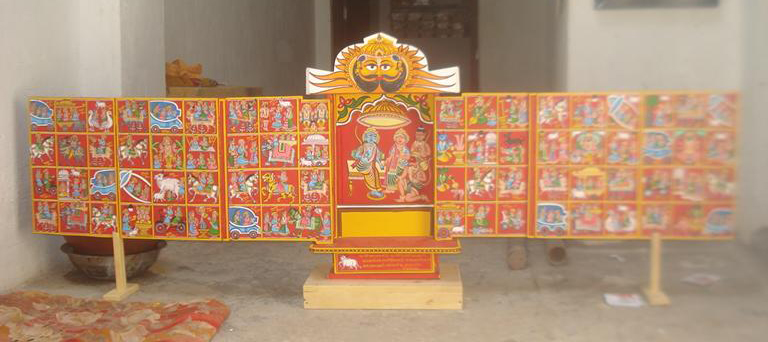
Kaavad is made by the Suthar (carpenter) community in Mewar, situated amidst the hills of the Aravalli ranges in Rajasthan. The specific identity of Kaavad makers comes from the place Bassi, the place where Kaavads are originated from. The Suthars of Bassi calls themselves the children of Visvakarma, the God who is considered as the chief architect of the Universe and the father of carpenter community. Out of 25 families of Suthars in Bassi only five to six families are involved in making of Kaavads.
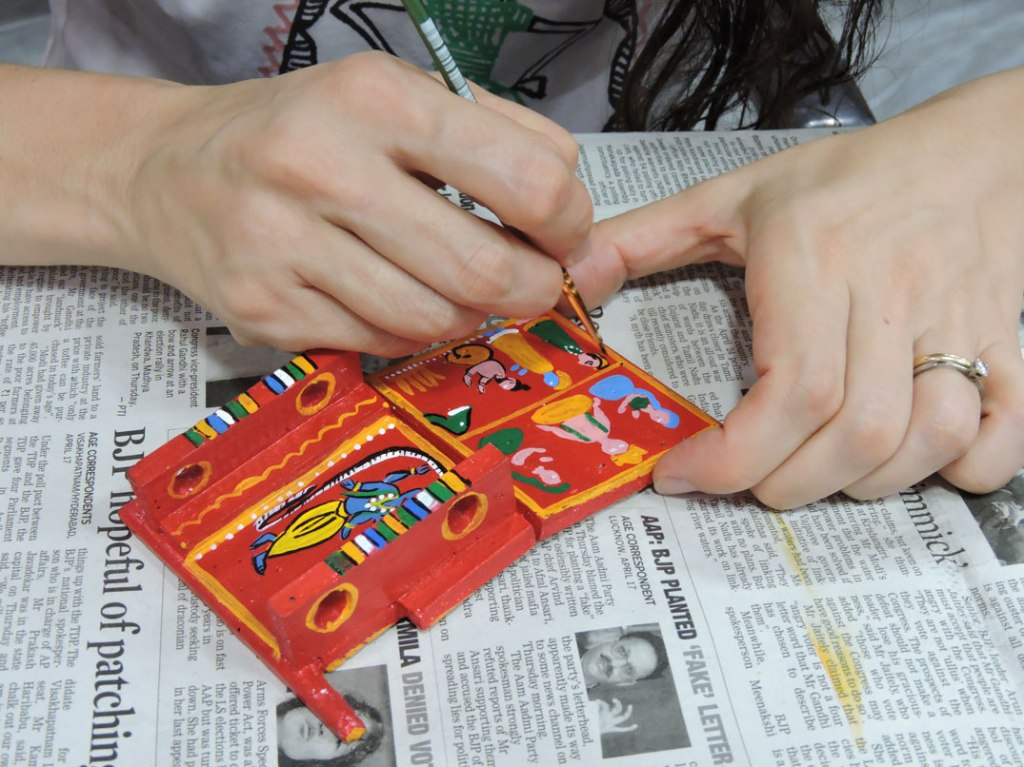
Kaavadiyas procure Kaavads from the Suthars of Bassi and then travel along with it from village to village to tell a lot of marvelous stories. On his arrival at a village, the storyteller holds the Kaavad against his chest, tilted slightly backward so that everybody could see the mobile Kaavad-shrine.During Kaavad bhachana, he sits crossed legged and keeps Kaavad over his lap.

The story begins by opening the small outer doors revealing the decorations on the outer panels to arouse the curiosity by talking through the highlights of the stories depicted in the Kaavad.The storyteller then opens a ‘donations’ flap located under the decorated panels.The storyteller opens panels, one by one, telling the unveiling the several episodes of the tale.Sometimes a story could last for several days. One Kavad can contain many linked tales.The grand finale of the tales comes as the storyteller opens the final panels to reveal a ‘shrine’ –housing 3D sculptures of the hero, his wife, companions, and other characters of the story, where everyone lives happily ever after.
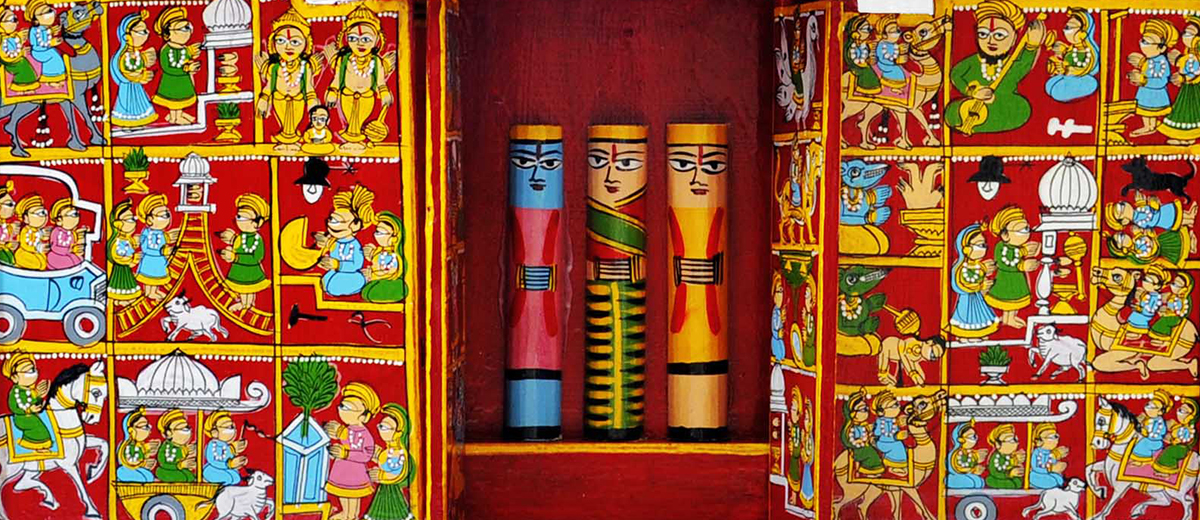

Storytelling of tribal tradition….
“Jhabua” famous for doll making, the locals refer to call this doll making as ‘Adivasigudiyashilp’.

Jhabua is predominantly a tribal district located in the western part of Madhya Pradesh. Bhils, Bhilalas and Bhagoria tribal communities are mainly found there. Jhabua has all district level basic necessary infrastructure and administration like government hospital, bus stand, magistrate court, police headquarters and markets.

Though urbanization is stimulating the lifestyle of these rural Adivasis, one can still find a handful of successor of Adivasi culture in weekly Haat bazaars (markets). In these haat bazaars, you can get a variety of handmade material products including bamboo products, dolls, beaded jewelry and other indigenous items.
In these Haats,the Bhagoriya Haat Festival is very famous. Bhagoria is not just a festival but actually a series of festivals held consecutively in different villages on their specific market days, starting eight days before Holi. I have heard many interesting facts about the Bhagoriya Hat Bazaar. In the past, the Bhagoria haat was the place for settling old disputes; open invitations were sent to enemies to fight in the haat. Bloody fights were quite common in the past; but today police and administration do not allow people to go armed to the haat.

Another interesting fact is that earlier there was no concept of matrimonial so this festival became a place where boys and girls of marriageable age meet and run away after choosing a partner (Run Away is Bhag in Hindi, so we call this community Bhagoria), As per tradition, the boy and girl apply Gulal (colored powder) on each other’s face whom they want as a spouse. This may not happen immediately, but the boy may pursue her and eventually succeed.
If I were one of this tribal community, I would dress up in my best outfits and makeup before embarking on the groom search. Otherwise, looking for a groom in urban cities is a task of wild goose chase. Well, jokes apart!!!😊 .So, as I mentioned, you will find boys and girls in their traditions attire during this Bhagoria haat festival.
I visited this Haat bazaar last year to compare the similarity of these dolls and I found that these dolls are really a symbolic representation of the Bhil and Bhilala tribe and their historical ethnicity.
The tradition of doll making in Jhabua is many generations old. These dolls represent the lifestyle of tribal men and women in colorful traditional outfits and ornaments. They adorn the female doll with silver jewelry like Galsan Mala (pearl necklace) or Chaandi ki Hansli (silver necklace), Kadas (bangles) and colorful Bhagoriya bridal wear Ghagra/Choli along with small utensils like bamboo baskets and earthenware.

On the other hand, the male counterparts in Dhoti & Kurti are seen with traditional Teer Kaamthi (bow and arrow) – highlighting hunting and gathering as primitive pursuits of this tribe. Such symbolic representation of the Bhil and Bhilala tribe, its existence and ethos, makes these small dolls an important medium of expression of historical ethnicity.

As raw materials they use colorful scraps of fabric, clay, plaster, cotton, wires, beads, metal jewelry, silver paint, and bamboo. The facial expressions are painted with great attention to detail. These dolls in themselves tell their glorious traditional stories. Different variety of these dolls u can find at ‘Shakti Emporium’ known as ‘Gudiya Ghar’ owned by a private entrepreneur Mr. Subhash Gidvani who has been practicing it for 35 years.



















